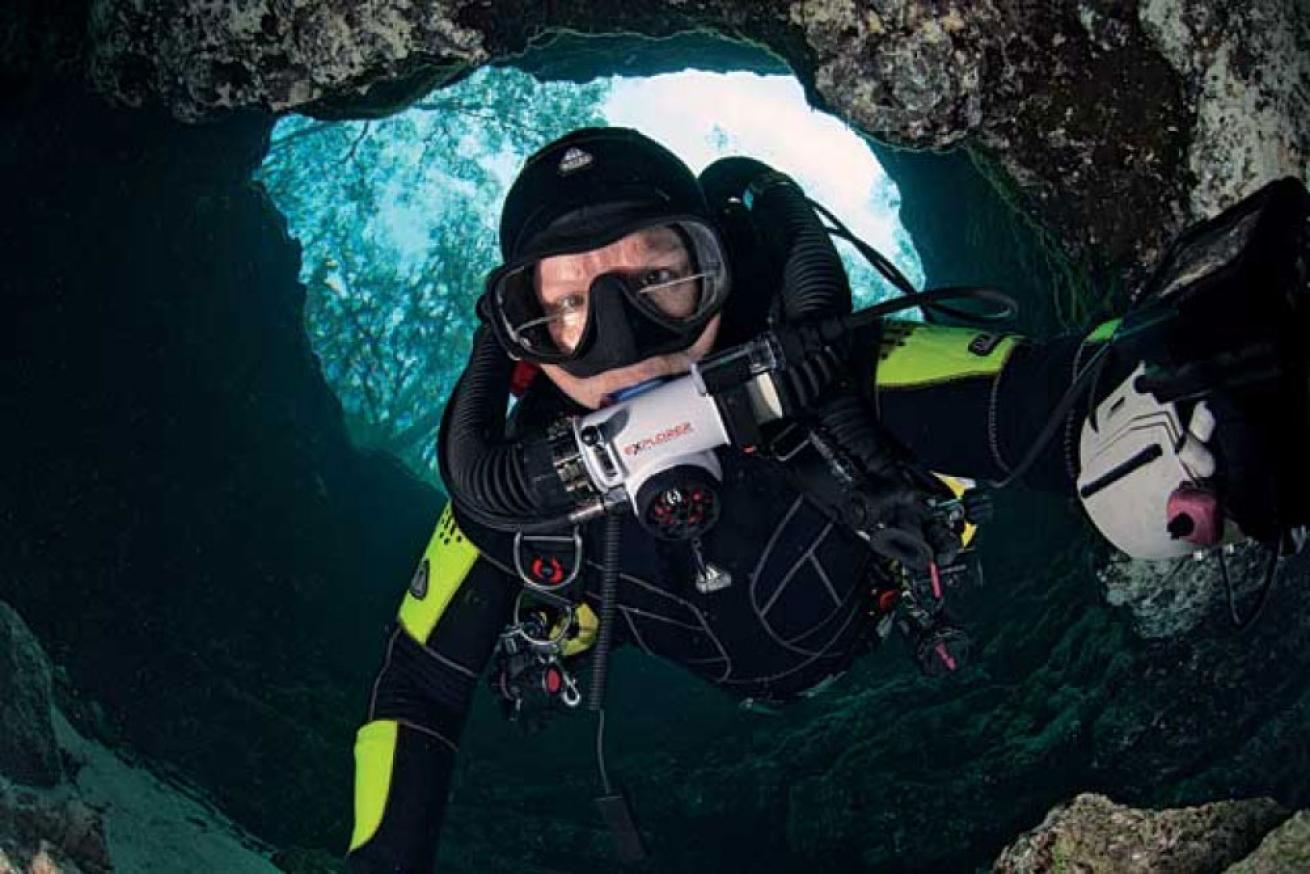Ask an Expert: Is the New Breed of Rebreathers Really Recreational?

Rebreathers
Jill Heinerth
I’ve always been a believer in using the right tool for the job. While a bigger, heavier hammer might be helpful driving nails, you don’t use a sledgehammer to build a house. There is a new breed of diving rebreather, simplified for the recreational market, referred to as “Type R.” But is it really recreational?
Yes, Type R Rebreathers Really Are Recreational
Recreational rebreathers are designed for the recreational diver. You have to be willing to take additional training and to perform additional steps to get ready to dive, but technological advances have moved bubble-less diving and super-extended bottom times into the realm of the recreational diver.
“The new Type R rebreathers really are for recreational divers. They use innovative programming and design to eliminate many user errors and to take on much of what used to burden the diver. This opens closed-circuit to the mainstream diver, much as Windows and Mac OS brought computing to the average person. These rebreathers do require special training — you don’t just buy one as an open-circuit diver and jump in the water — and open-circuit will probably remain the dominant technology, but they are clearly intended for, and becoming, mainstream.”
Karl Shreeves, Technical Development Executive, PADI
“Are these rebreathers suitable for all recreational divers? Not on your life. Rebreathers are a lot more complex than an open-circuit kit, which is probably the best choice for most recreational divers. But divers who have the discipline, focus and enthusiasm — and money — to take their diving up a notch might find one of these Type R rebreathers to be just the ticket.”
Michael Menduno, Founder and Editor of AQUACorps: The Journal for Technical Diving, and Organizer of Rebreather Forums 1 & 2
No, Rebreathers Still Have a Way to Go
Rebreathers may be recreational at some point, but they are lacking. The extra work, precautions and risk involved keep rebreather diving in the technical- and professional-diving world.
“No, not yet. Due diligence is still required by the diver, and the human still has to make the decision to dive. Electronics will never replace the human component.”
Pete Nawrocky, Field Project Manager, Dive Rite
“Most contemporary rebreathers are recreational, meaning they are used by nonprofessional divers and nonmilitary divers. However, most existing rebreathers require a level of technical skill that surpasses what most casual divers are willing and able to do. Thus, most rebreather diving is in the technical-diving domain."
“Recent development in rebreather technology is targeting casual divers. Modern ‘recreational rebreathers’ are in continual development, but at the current state of the art, they could serve the purpose. As with all new technologies, it might take longer to get casual divers to embrace recreational rebreathers. I am quite sure that CCR will be commonly used by mainstream recreational divers. How many more models could appear and disappear before it happens is hard to predict.”
Petar J. Denoble, M.D., D.S.C., Vice President, Research, Divers Alert Network
Conclusion
Each expert agreed that diving using rebreathers comes down to the diver and his or her dedication. Recreational rebreathers have come a long way, but the diver still needs to take additional training and practice regularly.
“Rebreathers are tools. They come with their benefits and their challenges. As long as the diver religiously follows his training and understands the issues related to the use of the equipment he is using, rebreathers are as safe as any other piece of equipment. A review of the ‘triggering events’ common in diving accidents (including rebreather accidents) tells us that it is not equip- ment failure, but rather user error or a diver mistake that turns an unremarkable recreational dive into an accident. So, regardless of what equipment is being used, reducing or eliminating errors will reduce accidents.”
**Dan Orr, President of Dan Orr Consulting, President Emeritus, Divers Alert Network **

Jill Heinerth
I’ve always been a believer in using the right tool for the job. While a bigger, heavier hammer might be helpful driving nails, you don’t use a sledgehammer to build a house. There is a new breed of diving rebreather, simplified for the recreational market, referred to as “Type R.” But is it really recreational?
Yes, Type R Rebreathers Really Are Recreational
Recreational rebreathers are designed for the recreational diver. You have to be willing to take additional training and to perform additional steps to get ready to dive, but technological advances have moved bubble-less diving and super-extended bottom times into the realm of the recreational diver.
“The new Type R rebreathers really are for recreational divers. They use innovative programming and design to eliminate many user errors and to take on much of what used to burden the diver. This opens closed-circuit to the mainstream diver, much as Windows and Mac OS brought computing to the average person. These rebreathers do require special training — you don’t just buy one as an open-circuit diver and jump in the water — and open-circuit will probably remain the dominant technology, but they are clearly intended for, and becoming, mainstream.”
Karl Shreeves, Technical Development Executive, PADI
“Are these rebreathers suitable for all recreational divers? Not on your life. Rebreathers are a lot more complex than an open-circuit kit, which is probably the best choice for most recreational divers. But divers who have the discipline, focus and enthusiasm — and money — to take their diving up a notch might find one of these Type R rebreathers to be just the ticket.”
Michael Menduno, Founder and Editor of AQUACorps: The Journal for Technical Diving, and Organizer of Rebreather Forums 1 & 2
No, Rebreathers Still Have a Way to Go
Rebreathers may be recreational at some point, but they are lacking. The extra work, precautions and risk involved keep rebreather diving in the technical- and professional-diving world.
“No, not yet. Due diligence is still required by the diver, and the human still has to make the decision to dive. Electronics will never replace the human component.”
Pete Nawrocky, Field Project Manager, Dive Rite
“Most contemporary rebreathers are recreational, meaning they are used by nonprofessional divers and nonmilitary divers. However, most existing rebreathers require a level of technical skill that surpasses what most casual divers are willing and able to do. Thus, most rebreather diving is in the technical-diving domain."
“Recent development in rebreather technology is targeting casual divers. Modern ‘recreational rebreathers’ are in continual development, but at the current state of the art, they could serve the purpose. As with all new technologies, it might take longer to get casual divers to embrace recreational rebreathers. I am quite sure that CCR will be commonly used by mainstream recreational divers. How many more models could appear and disappear before it happens is hard to predict.”
Petar J. Denoble, M.D., D.S.C., Vice President, Research, Divers Alert Network
Conclusion
Each expert agreed that diving using rebreathers comes down to the diver and his or her dedication. Recreational rebreathers have come a long way, but the diver still needs to take additional training and practice regularly.
“Rebreathers are tools. They come with their benefits and their challenges. As long as the diver religiously follows his training and understands the issues related to the use of the equipment he is using, rebreathers are as safe as any other piece of equipment. A review of the ‘triggering events’ common in diving accidents (including rebreather accidents) tells us that it is not equip- ment failure, but rather user error or a diver mistake that turns an unremarkable recreational dive into an accident. So, regardless of what equipment is being used, reducing or eliminating errors will reduce accidents.”
**Dan Orr, President of Dan Orr Consulting, President Emeritus, Divers Alert Network **










